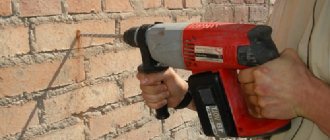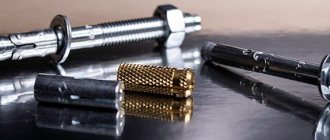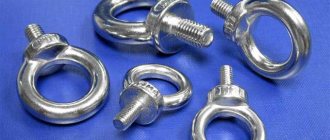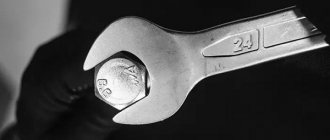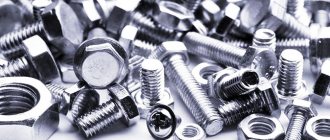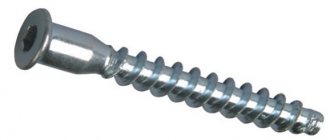A foundation bolt, or more precisely, an anchor, is an important element of any building structure, be it a multi-story building or a private building. They are used both on small objects and on large ones, such as bridges and foundations of factory workshops. Their main task is to ensure reliable adhesion of the walls to the foundation. This increases the stability of the building and also protects it from various seismic activities and natural loads.
In this article we will talk about what foundation bolts are. What types of them are found and how to choose the right fasteners depending on the purpose of the building and other characteristic features of the building.
What are foundation bolts-anchors
Structures of this kind are primarily intended for industrial purposes and are intended for fixing metal structures - machine tools, machines and other industrial equipment - to concrete. In essence, they act as mortgages. And this article will tell you in detail about the dimensions, length, weight of foundation bolts (anchors).
This video will tell you what a foundation anchor is:
Product structure
Fundamentally, the design of a foundation bolt is no different from a conventional anchor:
- a notched pin – inserted into the wall of a structure or used as a fastening element for a mechanism;
- anchor part - extension, embedded in a concrete base;
- the upper part of the anchor can vary greatly in shape and is determined by its purpose.
The principle of fastening, which ensures the retention of the structure, also fully corresponds to the concept of an anchor - an anchor. Three forces can act:
- friction - the fastener absorbs the load from the structure and transfers it to the monolithic base due to the friction forces that arise during expansion. Which, in fact, determines the obligatory presence of an expanding part;
- stop - the load perceived by the fastener and compensated by the resistance of the material itself;
- gluing is a load compensated by stress at the point of contact between the base material and the anchor. This factor operates in chemical foundation anchors and in cases where the structural form does not provide for support.
The design and dimensional parameters of foundation bolts-anchors are regulated by GOST 24379.1-80 and GOST 24379.0-80.
Since the fastener is designed to secure heavy structures in very dense materials, its strength must be outstanding. Typically, high-quality or high-quality carbon steel, as well as low-alloy steel, are used for this. It is possible to make anchors from stainless steel, but, as a rule, such products are made to order. Only galvanized fasteners may be used.
Advantages and disadvantages
Products of this kind are highly specialized.
In their field, foundation bolts have no competition, but they are not used in other fields. The advantages of anchors include:
- very high load-bearing capacity;
- wide variety of designs. The methods of fastening equipment are different, so products are produced with a wide range of design differences;
- There are 2 installation methods available. This allows the use of bolts both during construction and at later stages;
- large size range - depending on the purpose, products with lengths from 15 cm to 5 m are produced;
- Despite the fact that high-quality steel is used for manufacturing, the cost of the products is relatively affordable.
Disadvantages of the product:
- the foundation anchor is not universal. Its scope is limited to the installation of structures on a concrete base;
- its use requires certain knowledge, since accurate calculations are important here, taking into account the foundation material, design features, installation method and much more.
The following describes the types of foundation bolts.
This is interesting: Production and operation of tubing pipes
Operating principle of the fastener
The action of the bolt to relieve dynamic and static loads on the foundation is based on the interaction of three force components:
- The friction force between the surface of the rod and the concrete is directed perpendicular to the sliding direction. To increase the expanding force, the end of the bolt is equipped with an expanding collet or a cone-shaped thickening.
- Material resistance is the internal force of a steel rod that resists fracture, crushing, and deformation that occurs when the bolt rests in a concrete base.
- The occurrence of a shear stress force upon contact between the surface of a bolt and concrete.
The interaction of the three forces ensures reliable, strong, durable fastening of structural elements to concrete foundations at all stages of construction, from laying the pile foundation of a house to the construction of dams, bridges and nuclear power plants.
What are foundation bolts?
Foundation bolts belong to the category of anchor-type fasteners, the principle of operation of which is determined by their very name. The word "anker", if translated from German, means "anchor". It is no coincidence that such a definition is used in relation to fasteners of a certain design.
Literally cutting into the structure of the material of the structure, such a fastening element forms a reliable connection with it, capable of withstanding significant static and dynamic loads. Naturally, in order for the load-bearing capacity and reliability of such bolts to be at the proper level, only high-quality and durable materials are used for their manufacture, and their surface is covered with a layer of zinc, which protects them from the effects of negative environmental factors.
Foundation bolts with collet end (type 6.1)
Considering that such bolts can be used for installation in foundation structures of various sizes, the length of these products can vary significantly. Thus, on the modern market you can purchase anchor-type foundation bolts with an embedment depth from 15 centimeters to 5 meters. The diameter of such bolts, which increases with their length, can also correspond to different values.
Materials for the manufacture of anchor bolts
During installation, the hardware enters the structure of the base, and as a result, a strong connection is formed that can withstand critical weights. And in order for the bolts to be characterized by increased resistance to all kinds of loads, manufacturers choose the best grades of steel.
Curved foundation bolts are made from steel, which is coated with a layer of zinc. This specialized treatment provides protection from the effects of adverse environmental conditions. The main function is to prevent the occurrence of corrosion during operation.
Areas of application
The main task of foundation bolts is to ensure reliable adhesion of the walls to the base. Anchors are installed in several ways: by driving into a pre-drilled hole, and by laying at the stage of pouring the foundation. The second method is considered more reliable, but requires a careful approach to installation, since it is necessary to take into account not only the distance between the anchors and the depth, but also the accuracy of installation relative to the vertical axis.
In addition, anchors are used to attach machines to foundations. The main task here is to remove the load from the concrete that is created by the vibration of the machine. Such fasteners have a slightly different design, and can also be mounted at the pouring stage in the form of an embed or in drilled holes.
Anchors can also be used in the construction of extensions, when it is necessary to connect a new wall to an old one. In this case, the task of the hardware is not only to reliably connect the structures, but also to evenly distribute the load between them.
Basics of the principle of connecting anchors
Anchor connectors are held inside the foundations due to the influence of various forces - emphasis, gluing, friction, but they arise when the monolith interacts with the connection.
During the spacer of the expanding collet, similar forces arise; the stop is distributed over the bolt, where it is compensated by internal resistance, which contradicts the breaking force.
Bonding eliminates the pressure arising from shear stress at the point of contact between the anchor and the concrete.
The choice of fasteners is carried out based on the expected load on one point. The features of the base are taken into account to find the desired type of fastening. An important factor is the main characteristics of the foundation: type, degree of strength, structure.
The size of the anchor system used is selected based on the physical parameters of the structure being installed. The larger and heavier the structure, the longer and thicker the bolts should be.
Then, the optimal distance between the bolts is calculated, according to the weight, dimensions of the attached structure or technical support.
Recommendations for the correct installation of anchors can be viewed in the following video:
The use of such hardware
The area of use of the foundation anchor is determined by its qualities: high load-bearing capacity and durability. Application is limited to the base material.
Fasteners can only be installed in heavy, dense materials:
- concrete – heavy and especially heavy;
- natural stone;
- solid brick; fastening into hollow brick is prohibited.
Despite the specificity, many works are carried out using anchors, both large industrial and household ones:
- first of all, this is the installation of industrial equipment: machine tools, machines, pressing and electrical equipment, and so on;
- when repairing foundations, new fragments are bolted to old ones;
- when installing a beam grillage - in this case, the anchor is fixed in the pile, and the tie-rods are attached to it. This method, in addition to reliability, also ensures the absence of cold bridges;
- anchors mount the base during installation in order to use them as fasteners for the facing material. This option is more reliable than laying hooks under the cladding;
- In everyday life, a foundation bolt is most often used when attaching large-scale attachments. The anchor is stronger and more durable than self-tapping screws and dowels.
Popular product brands
Many companies are engaged in the production of foundation bolts. These products are quite simple to manufacture and are quite in demand. The most famous foreign companies include Simpson Strong-Tie, Hillman Group, USP. In Russia, Neva Resources is also the largest.
- The cost of products depends on the size, the quality of the steel, and the design.
- A straight carbon steel foundation bolt will cost 70 rubles. per kg. The same stainless steel fasteners cost from 613 rubles. per kg.
- A bolt with a conical end costs from 320 rubles. per kg. But just a flat anchor plate for a bolt will cost 3,202 rubles. per piece
- A composite foundation bolt costs from 355 to 5750 rubles. per piece
A foundation anchor is a special type of fastener designed to fix heavy structures to dense material. It is indispensable when fastening equipment, for example, or building structures, but is practically not used in other areas.
Types according to the method of installation in the foundation
According to the criterion “method of installation in the foundation”, this type of fastener is divided into 2 categories.
- Parts to be installed before the foundation is filled with concrete. This group includes bolts:
- removable type;
- composite elements;
- equipped with an anchor plate;
- curved (made according to design drawing 1).
- Bolts that are installed on foundations with hardened concrete that are ready for future use in wells or wells created in advance. This category includes:
- fasteners equipped with a conical end;
- bolts are straight;
- Curved bolts (version 1).
The following point deserves attention. The procedure for installing removable fasteners involves placing exclusively anchor reinforcement into the foundation. And the rod, in turn, is installed in the framing pipe upon completion of the foundation itself.
Main types
Anchor bolts, which are used for embedding in foundation blocks, are produced by modern industry in various sizes and designs. If we talk about the classification of such fasteners, then all of them can be divided into several main types.
Curved
Such products, manufactured in accordance with the requirements of GOST 24379.1-80, are made in the form of a metal pin, the end of which has a curved shape and resembles a hook. In accordance with the above GOST, the maximum length of such fasteners is 180 cm. They are used in foundation structures made of reinforced concrete.
A bent foundation bolt consists of a stud, two nuts and a washer. The latter can be enlarged for mounting equipment with a large diameter of mounting holes
With anchor plate
Such bolts, the length of which according to GOST can reach up to 5 meters, are also used for installation in reinforced concrete foundation structures. Structurally, foundation bolts of this type are a metal pin, on the lower threaded end of which an anchor plate is fixed using additional nuts, ensuring their reliable fixation in the concrete base.
The design of the anchor plate depends on the design of the foundation bolt
Composite
The depth of embedding of such bolts can also reach several meters. The design of such fasteners, which are manufactured in accordance with the requirements of regulatory document 24379.1-80, includes a metal pin, a threaded rod, a coupling and an anchor plate. Composite foundation bolts are used in cases where it becomes necessary to tie one structural element to another.
Composite foundation bolts are equipped with various types of studs
Removable
The regulatory document for the manufacture of bolts of this type is also GOST number 24379.1-80. A removable bolt, which is a metal pin equipped with a special anchor system, is used for embedding into brick, stone and reinforced concrete foundation structures. With the help of such fasteners, engineering and technical structures for various purposes are installed.
The anchor reinforcement of removable foundation bolts is made of composite, cast or welded
Direct
These are foundation bolts, which are ordinary metal pins. Their length can reach 140 cm. Straight bolts must also meet the requirements of GOST 24379.1 from 1980. Bolts of this type can be installed in a ready-made foundation. In such cases, special glue or cement mortar is used to fix them in pre-drilled holes.
Straight bolts provide reliable fastening only on a solid base, eliminating deformation loads
Kinds
The types and types of foundation bolts are strictly prescribed in the state standard. There are quite a few varieties, and they are selected depending on the purpose and tasks. There are both very simple designs in the form of a single stud with a nut at one end, and complex, composite elements that can create a thrust inside the concrete structure, thereby ensuring a reliable connection. In some cases, special glue or concrete mortar is used to fix the bolt inside the base. These standards for large construction projects are also strictly regulated and specified in GOST.
Curved
Curved anchors are designed for fixing industrial equipment to a concrete base. GOST distinguishes two types of such bolts:
- Straight bolts. This is a straight pin with a 90 degree bend at the end.
- And with deviation. Here, approximately in the middle of the stud, there is a deviation to the side, and the bolt ends with a 90-degree bend.
The first type of anchors is intended for installation at the stage of pouring the foundation. The second is installed in drilled wells. That is, holes are drilled in the finished foundation with a diameter corresponding to the maximum bending width of the anchor. Next, the bolt itself is installed in the hole and fixed with concrete mortar. Due to the weakening of the entire structure, the bolt has such a configuration, which restores strength to both the base and the fastening itself.
The length of such anchors varies from 30 to 180 centimeters. They are selected depending on the design load and the depth of the concrete base. The regulations also stipulate the minimum and maximum nut size and stud diameter. The minimum thread size is 12 millimeters, and the maximum is 48. Depending on the region, the requirements for the materials used in manufacturing may vary. Thus, in regions with high humidity or strong temperature changes, additional requirements are placed on the steel grade and coating.
With anchor plate
A universal type of fastener designed for connecting building structures to each other. The material doesn't matter. In essence, this is a very simple design consisting of only two elements: a central stud and a lag nut. There is a large anchor plate at one end of the stud. It serves as a stop for fasteners and prevents destruction of the material when tightened.
The anchor can be used both in the form of a mortgage and for connecting already constructed structures. It is enough to drill a hole of the appropriate diameter and drag the bolt through it, tighten it with a nut. GOST provides for a division into 3 types, but the difference between them is not significant. The first type is the most compact and has a thread diameter from 16 to 48 millimeters. The third type is the largest and the nut size reaches 140 millimeters.
The standard clearly defines the size of the anchor plate and the thickness of the metal from which it is made. Depending on the size of the stud, the size of the plate itself is also determined. To understand what size slab will be on the selected anchor, just look at the table below:
Parameter B is the length of one of the sides of the square or the diameter of the slab in its round configuration. Parameter S – determines the thickness of the metal from which the plate is made.
Composite
Composite bolts, as the name implies, have a collapsible design and are manufactured in accordance with GOST, marked type 3. They consist of several elements:
- Central stud;
- coupling;
- Anchor plate;
- Clamping nut with washer.
The coupling is used to connect two parts of hardware. The lower part is installed into the foundation at the pouring stage or into a drilled well. After the concrete base has hardened and the structure to be held has been installed, the upper part of the anchor is screwed in.
In the state standard, composite bolts are divided into two types. They differ only in the diameter of the central pin and overall size. So, the first type is manufactured in the range from 24 to 28 millimeters. And the second is from 65 to 140 millimeters. The length of the stud ranges from 30 centimeters to 180. The standard does not impose requirements on this parameter; in addition, it is possible to manufacture composite bolts according to an individual project. The presence of a protective layer is mandatory, and regional requirements are prescribed separately depending on the conditions in which the anchor will be operated.
Removable
The most common type of fastener used in construction. The main purpose is to connect the wall to the foundation. Consists of three parts:
- Anchor reinforcement mounted directly into the foundation;
- Central stud;
- And a fastening nut with a washer.
The installation process is as follows: at the stage of pouring the foundation, anchor reinforcement is placed in it, which is the basis of this hardware. The lower part of the reinforcement has an extension that ensures secure fastening and stability of the bolt. Next, the central pin is screwed in and rows of bricks or other building materials are laid. When the required height is reached, the nut is tightened for final fixation.
The state standard distinguishes 3 types of such bolts, and they differ only in the diameter of the thread and, accordingly, the size of the stud. The minimum thread size is 24 millimeters, and the maximum is 125. The length of the stud is not regulated, so it is possible to manufacture according to an individual project, provided that there is an engineering calculation.
Direct
The simplest type of bolts of a primitive design. This is a straight stud made of alloy or carbon steel, one end of which is equipped with a thread and a clamping nut. Such bolts are installed in finished foundations. The mounting hole is drilled to a larger diameter, and the resulting void is filled with concrete mixture or special glue.
Despite the simplicity of the design, the bolt has high technical characteristics, although it has a number of restrictions on use. Most often, such fasteners are used in the construction of small buildings or for strengthening on the basis of industrial machines that do not have a high level of vibration.
There are no requirements for the length of the hairpin in the state standard. The only parameter regulated by GOST is the diameter of the stud used. It ranges from 12 to 48 millimeters. Bots can also have a protective coating, if this is necessary and it is necessary to increase the resistance of the hardware to natural influences.
With tapered end
The most convenient type of fastener, allowing you to make strong connections in a ready-made foundation. The bolt consists of a central pin equipped with a thread and a conical piece at the other end. GOST distinguishes three types of such bolts:
- It is equipped with an expanding collet, which wedges when the nut is tightened.
- It has a conical bushing with internal thread at the end. The bolt does not wedge, but can be removed by unscrewing the central sleeve.
- The third type is a simple pin with a flare at the end. The simplest type of anchor, immersed in a drilled hole.
Unlike straight foundation bolts, tapered ones have an increased level of strength. They are mounted in holes, the voids in which are filled with concrete solution or special glue. For the first type, filling the hole is not relevant, since the diameter of the anchor corresponds to the diameter of the hole and is hammered inside, and the expanding collet firmly wedges the hardware inside the block.
Varieties
No matter how simply a monolithic foundation is constructed, in reality it turns out that there are many factors at work here that significantly affect the reliability of the fastening. Accordingly, foundation bolts have many varieties.
By design features
Based on their design features, foundation anchor bolts are divided into the following types.
- Curved - consists of a stud, washer and two nuts. One end of the pin has a curved shape - a hook. According to GOST, the maximum length of the product reaches 180 cm. An anchor is used for fastening metal and reinforced concrete structures. The washer can be of different sizes to suit equipment with different mounting holes. Fasteners are used if the height of the foundation does not depend on the depth of the anchor.
- With anchor plate - at the lower threaded end of the pin there is an anchor plate secured with threaded nuts. The slab determines the reliability of fastening in concrete. The structure can be different, which is determined by the structure of the foundation. The maximum length of the product is 5 m. An anchor is used for fastening metal and reinforced concrete structures. This option is installed for concreting. It has a smaller embedment depth, and therefore is used when the height of the base depends on the embedment depth.
- Composite with anchor plate - in addition to the threaded rod and anchor plate, a coupling appears, which allows you to connect the two parts of the anchor bolt. In this way, two structural elements mounted by turning or sliding are connected. The general installation scheme is as follows: a part of the stud with a coupling is concreted into the foundation, then the mechanism is installed and the upper part is screwed into the coupling. The screw-in length is at least 1.6 times the thread diameter.
- Removable - mounted in a poured foundation. The anchor plate can have different designs: welded, cast, flat anchor plate. This option is designed for fixation into a concrete, brick or stone foundation. Most often they are used to secure rolling equipment, since it is subject to high dynamic loads. Also, removable fasteners are required in cases where, as practice shows, the bolts will have to be replaced over time. The removable bolt is mounted slightly differently: only the anchor part is concreted into the foundation, and the stud is installed after the foundation is laid out.
- Straight is the simplest modification, consisting of a metal pin and nut. The length can reach 140 cm. This option is designed for installation in a ready-made solid foundation, when deformation loads are excluded. A straight anchor is attached to an adhesive or cement mortar and is held in place by adhesive forces. Their usual application is construction work.
- Spacer with a conical end - installed in a finished foundation, a hole is pre-drilled for it. The fasteners are fixed using expanding collets or cement mortar. Fasteners are also used in construction work, but when constructing structures subject to vibration loads.
Foundation anchor bolt (varieties)
According to operating conditions
Fasteners vary depending on operating conditions:
- calculated - the anchor absorbs the load that occurs during operation of the equipment and transfers it to the foundation;
- constructive - their main task is to ensure stable operation of mechanisms and prevent accidental shifts. In this case, resistance to overturning or displacement is provided mainly by the weight of the structure or machine itself.
By installation method
Based on the installation method, the following types of foundation bolts are distinguished:
- installed before concreting - most types are fixed in this way: curved, with an anchor plate, and so on;
- those installed in a finished foundation are straight and spacer. To install them, you need to drill a hole in the concrete. An anchor that is fixed into a finished base is prohibited from being used in the construction of high-rise buildings, since the wind load is the main one for them.
The production of foundation anchor bolts is captured in this video:
Installation of fasteners
Before installing anything using foundation anchor bolts, it is necessary to make accurate calculations. Each product requires a certain load and operating conditions, which must be taken into account.
Material calculation
To calculate the required fastener parameters, you need to know:
- static and dynamic loads to which, depending on operating conditions, the equipment is subjected;
- design tensile capacity of the product;
- ultimate compressive load;
- operating conditions - if the structure will be used at a temperature not lower than -40 C, then the anchor can be made of steel grades VSt3kp2, VSt3ps2, St20. If temperatures down to -65 C are expected, then steel 09G2S-8, 10G2S1-8. When fastening devices intended for processing or storing explosive substances, products made of VSt3ps3 steel are required;
- cross-sectional area - calculated from the strength requirements that are necessary for reliable fixation of the equipment. Moreover, different formulas are used for static and dynamic loads;
- pre-tightening force - also determined taking into account the type of load: static or dynamic;
- embedment depth - determined by the load and weight of the elements being fixed;
- pitch between bolts - calculated as 2 embedment depths in the usual case.
Only after careful preliminary calculations can you begin laying out the elements.
Technology
The procedure for installing anchors in the foundation itself is simple and is often done independently in private construction.
- Based on the building plan, the installation locations are marked. Foundation bolts are only needed when installing permanent walls. They are not installed under doorways, for example.
- After constructing the formwork, the foundation is poured with concrete until the material has set, but already has sufficient viscosity, and anchors are immersed in it. It is allowed to deepen the bolt no more than half, and preferably less. There should be at least 6 cm above the surface of the future foundation. It is recommended to wrap the threaded part of the fastener with film.
- The distance between the bolts is equal to the sum of 2 depths.
- Anchors are positioned strictly vertically. For larger sizes, special devices are used.
- The bolts are formed into a block. To do this, prepare a metal or wooden plate, drill holes in it and secure it with bolts.
It is possible to install straight bolts with glue - silicone or epoxy. Holes for anchors are drilled in the already solidified foundation, filled with glue and sand-cement mortar is also immersed in the holes.
Foundation bolts.
Installation of anchor bolts.
Foundation bolts for construction work.
During construction work, a huge number of different types of fastening elements are used that perform certain functions. A special place is occupied by threaded rods of various shapes, commonly known as foundation bolts. We will talk about the design of these fasteners, their types and use in this article.
Types of foundation anchors depending on the expected operating conditions
According to the criterion of “operating conditions”, these fastening devices are usually divided into two groups.
- Design foundation bolts. This category includes products that absorb the effects of loads that appear during the operation of powerful technological equipment or during the operation of various building structures.
- Structural foundation bolts. Fastening parts included in this group are used for reliable fixation of building structures or technological units, the resistance to shearing or overturning is ensured by their own weight.
Purpose of fasteners.
Bolts, sometimes called foundation anchors, are intended for fastening the lower crown of log structures to the building support, as well as connecting with other materials of external walls or installing various machines and mechanisms in industrial enterprises. In addition, to strengthen the base of the house, U-shaped or H-shaped steel profile parts, called channels and I-beams, are often attached to it.
Installation of anchor bolts in the foundation.
Purpose of foundation fasteners.
It is impossible to attach building blocks or beams to a smooth strip reinforced concrete or slab foundation without fear of all sorts of deformations and displacement of the structure. To solve this problem, long rods of one shape or another, called anchor bolts, are used.
Purpose of the foundation anchor
In foundation work, the anchor bolt plays the role of a fixator. Its lower part is attached to the base, and the upper part is connected to the foundation itself using threads. Anchor bolts have proven themselves in the construction of prefabricated structures and installation of massive equipment.
Fastener properties:
- reliable fixation of the rod in the foundation;
- installing strong bolts before you pour the concrete;
- guarantee of durability during installation work.
Only with the right choice of bolt installation can you count on its benefits. To navigate the location and correctly calculate the position of the fasteners, it is better to proceed from the design of the object. Information about supporting structures is taken into account. Only under them can anchors be installed.
Alphabetical index of terms in Russian
| anchor | 4 |
| driven anchor | 29 |
| screw-in anchor | 30 |
| injection anchor | 23 |
| capsule anchor | 24 |
| adhesive anchor | 21 |
| metal anchor | 12 |
| mechanical anchor | 10 |
| plastic anchor | 13 |
| drop-down anchor | 19 |
| expansion-adhesive anchor | 22 |
| countersunk anchor | 27 |
| anchor with press washer | 26 |
| anchor with wedge clip | 16 |
| anchor with extension | 15 |
| rigging anchor | 28 |
| disc anchor | 25 |
| persistent anchor | 14 |
| friction anchor | 18 |
| chemical anchor | 11 |
| self-tapping anchor screw | 17 |
| sleeve anchor | 20 |
| anchorage depth | 35 |
| anchor embedment depth | 34 |
| depth of installation hole for anchor | 33 |
| anchor group | 5 |
| diameter of mounting hole for anchor | 32 |
| temperature range for anchor installation | 39 |
| temperature range of anchorage operation | 40 |
| anchor dowel | 8 |
| anchor expansion zone | 31 |
| anchor fastening | 1 |
| pre-installation anchor fastening | 2 |
| Anchor fastening for through installation | 3 |
| construction base | 6 |
| Ultimate condition of anchorage | 37 |
| anchorage load-bearing capacity | 36 |
| anchor life | 38 |
| anchor rod | 7 |
| disc element | 9 |
Appendix A (for reference). Classification scheme for anchors and anchors
Appendix A (reference)
Figure A.1
| UDC 692.97:006.354 | OKS 91.120.01 |
| Key words: anchor, anchorage, classification, terms and definitions, anchor group, load-bearing capacity of anchorage, limit state of anchorage, service life of anchorage | |
The electronic text of the document was prepared by Codex JSC and verified according to: official publication M.: Standartinform, 2019
GOST standards
Anchor bolts are considered the most common method of securing buildings to the foundation. In parallel with assessing the quality of the parts themselves, there must be a thorough check of the foundation. Otherwise, there is a risk of breaking the bolted connections. The concrete must be strong enough to hold the anchor bolts. If the concrete is weak or porous, drilling bolt holes may cause cracking or crumbling. Therefore, no guarantee of strength exists in such cases.
Although supporting walls can provide structural stability, additional measures must be taken to reduce the likelihood of damage. Projects are developed taking into account not only permanent impact factors, but also potential seismic hazards. According to the Uniform Building Code, developed based on GOST, it is established that foundation slabs must be bolted to the foundation with bolts with a diameter of 1/2 inch at a distance of no more than 1.8 meters from each other. One bolt should be placed within 30.5 cm of each end of the plate section.
GOST standards regulate not only the structural features of bolts, but also prescribe the material from which parts should be made. The basic rule for all types of durable anchor bolts is production technology from alloy and carbon steel. If this is due to marking according to GOST, zinc is additionally applied to improve the properties of the bolts. It improves quality by protecting fastening systems from corrosion.
Zinc can be applied in two ways:
- Galvanic. The bottom line is that a hydrolysis bath is used for processing. Zinc atoms coat the surface of the anchor bolt.
- Diffusion. Galvanization occurs under the influence of high temperatures. Using the heating method, atoms penetrate the surface of the fastener.
Both methods have worked well, so you can use any of them to achieve results. It is important to adhere to the rules and regulations set forth in the building code.
Technical characteristics of connecting fasteners
Before installation, you will need to take into account all possible anchor parameters in order to select bolts.
Fastening blanks are produced with a stud diameter of 1-14 cm, with a maximum connecting bolt length of up to 5 m. Production can only use raw materials with the highest strength indicators.
Finished products exist in different classes, separated by strength, where the smallest permissible parameter is 4, and the highest is 13.
During practical application, additional processing is allowed.
Equipment according to GOST
GOST was developed on the basis of regulatory construction documents. It regulates the size of products, their quality, storage and transportation features.
As for the packaging requirements, the fasteners must consist of the following parts:
- main rod;
- anchor fittings;
- tile and sleeve;
- coupling and washer;
- clamping scurvy;
- screw;
- pipe.
Some components may be missing depending on the modification. To understand, in straight bolts the thread is screwed on only one side. Also there is only the center rod and nut. If we consider other more complex fasteners, their structure is improved and designed depending on the functions performed, the specifics of the fastening and the application. There can be several fasteners in the form of nuts and washers.
What are foundation anchor bolts made of?
Considering the loads and functions that are placed on anchor bolts, fasteners are made from high-strength materials. The preferred choice is steel. Manufacturers also offer varieties of it for increased resistance to temperature changes and precipitation. Additionally, the bolts undergo heat treatment. This reduces the likelihood of a connection being lost.
Depending on the design of the bolt, the loads it can withstand, and the manufacturer, the cost of fasteners also differs. When purchasing foundation bolts, it is important to make sure that they comply with GOST standards and have passed all the necessary tests. Only after quality control can parts be used for foundation work.
Foundation bolts are considered durable and reliable. Due to the high demand for high-strength bolts, various types of fastening systems are produced, differing in function.
The foundation anchor is attached to the structural support or wall elements. They are used to install massive equipment in industrial workshops.

